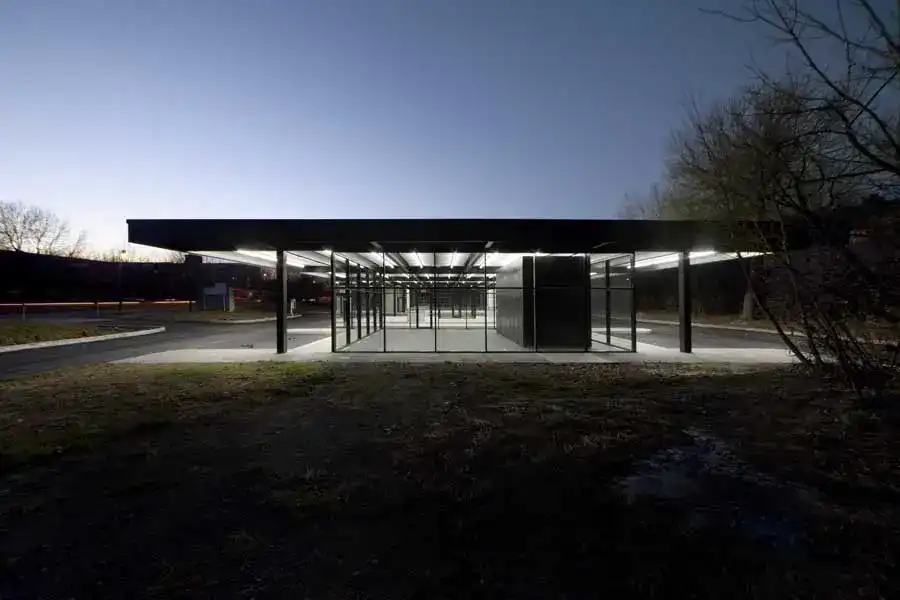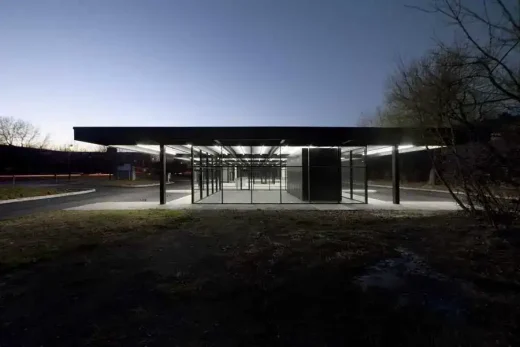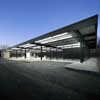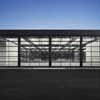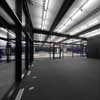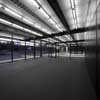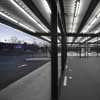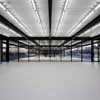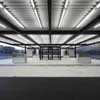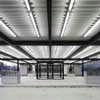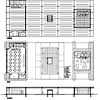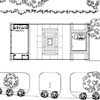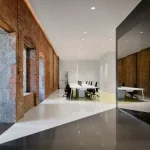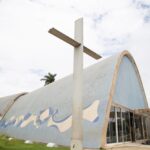Nuns Island Gas Station photos, Montreal Mies van der Rohe building design, Modern architecture Canada
Conversion of Mies van der Rohe gas station on Nuns Island, Montreal
Mies van der Rohe gas station, Montréal, Quebec, renewal design by Les architectes FABG
21 Feb 2012
Renewal Design: Les architectes FABG
English text (scroll down for French):
Photos by Steve Montpetit
Conversion of Mies van der Rohe gas station on Nuns Island
Montreal, February 16, 2012 – Nun’s Island is part of the Hochelaga archipelago located immediately southwest of Montreal. It’s urbanization followed the opening of the Champlain bridge in 1962 under an ambitious master plan carried out by Metropolitan Structures, a real estate giant who had built numerous projects in Chicago with the collaboration of Mies van der Rohe. The new community included three high rise apartment buildings by Mies office and it led, in 1966, to a commission from Standard Oil to design a prototypical gas station.
Gas Station on Nuns Island
The station consists of two distinct volumes, one for car servicing and the other for sales, with a central pump island covered by a low steel roof that unifies the composition. The beams and columns were made of welded steel plates painted black that contrast with the white enamelled steel deck and bare fluorescent tubes.
Over the years, the interiors have been modified to incorporate a car wash on the sales side, the finishes, built-in furniture and equipment have been replaced and the custom made pumps removed. It ceased to be commercially operated in 2008 and the city of Montreal listed it as a heritage building in 2009 before initiating the project of a youth and senior activity centre. This simple program requires an open space for each group to congregate and participate in communal activities.
The senior group occupies the larger volume to the benefit of its sixty members who play bridge, prepare communal meals, dance or invite lecturers. Stacking chairs and tables allow multiple configurations of the room.
The younger group occupies the smaller volume. Teenagers meet there daily to play games, listen to music, organize parties and events under the supervision of educators.
The first architectural task was to meticulously restore the envelope of the building by dismantling and repairing the corroded curtain wall, repointing the brick work and repainting the structure.
The second architectural task was to develop strategies for the new mechanical and electrical needs that would not affect the integrity of the heritage values. We choose to implement solutions originating from the sustainable development field of research to achieve this goal.
The new geothermal wells under the asphalt around the building provide the major part of the energy required to operate the building but they also radically diminish the size of the equipment and eliminate the need for a cooling tower on the roof of the building. The new stainless steel gas pumps are in fact air in take and out take devices that are linked by underground ducts to the HVAC system.
They replace the louvers that we would have had to install on the building and this solution contributes to the pre-cooling or heating of the fresh air admitted, the canadian well effect.
The third task was to radicalize the building with the new interventions in order to emphasize its inherent qualities and the essential values that it embodies. Formal unity and simplicity is enhanced by making everything black (teenagers side) or white (elders side).
The strength of the roof as a unifying device is reinforced by using the same rhythm of linear fluorescent lighting into the interior spaces (T-5 tubes on dimmers).
Transparency is augmented by opening completely the view from one end to the other on the long axis and by using low-iron glass. Specific uses and functions have been integrated into freestanding built-in units that are formally mute to dissimulate the contingencies of daily life.
The project is not about the faithful restoration of a monument. It is an interpretation trying to touch and communicate the essence of an artistic vision formulated by someone else in response to a world that is no longer the same. Musicians do this every day.
Mies van der Rohe Gas Station Conversion – Building Information
Project’s name: Reconversion de la station service de Mies van der Rohe à l’Île des Soeurs Localisation: 201 rue Berlioz, Verdun, Québec
Client: Arrondissement de Verdun
Architect: Éric Gauthier
Team: Marc Paradis, Dominique Potvin, Jaime Lopez, Steve Montpetit
Engineers: Aecom
Builder: Norgéreq
Cost: 1.4 M $
End of project: Septembre 2011
Photographer: Steve Montpetit
Source: v2com.biz
French text:
Station Service de Mies van der Rohe
Reconversion de la station service de Mies van der Rohe à l’Île des Soeurs
Montréal, le 16 février 2012 – L’urbanisation rapide de l’Île-des-Sœurs, consécutive à l’inauguration du Pont Champlain en 1962, a été largement dirigée par Metropolitan Structures qui fût l’un des principaux clients américains de Mies van der Rohe. L’agence de celui-ci fût ici impliquée dans la conception de trois immeubles résidentiels et d’une station-service pour la Standard Oil, qui fût opérée commercialement jusqu’en 2008.
Le statut patrimonial qui lui fût conféré en 2009 par la Ville de Montréal a orienté la définition d’un projet de restauration et reconversion en centre communautaire intergénérationnel.Les aînés occupent le pavillon de mécanique automobile transformé en salle multifonctionnelle pour des activités de groupe variées incluant danse, bridge, yoga et banquets. Les jeunes obtiennent le pavillon de ventes pour tenir des activités sociales en présence d’éducateurs.
Il a tout d’abord fallu restaurer l’enveloppe du bâtiment puis mettre en œuvre des stratégies pour intégrer les nouveaux équipements mécaniques et électriques sans affecter la valeur patrimoniale du bâtiment. De nouveaux puits de géothermie fournissent la majeure partie de l’énergie requise pour chauffer et climatiser le bâtiment.
Les gaines de ventilation circulant sous dalle sont également raccordées aux pompes à essence qui sont en fait des prises d’air frais. En tirant parti du principe du puits canadien, l’air est préchauffé (ou pré-refroidi) en circulant sous terre avant d’être admis dans le bâtiment.
Les interventions architecturales tentent de radicaliser les qualités inhérentes du bâtiment en accentuant la simplicité formelle, la continuité du toit et la transparence des pavillons. Les nouveaux équipements sont dissimulés à l’intérieur de blocs d’armoires, noirs chez les jeunes, blanc pour les aînés.
Mies van der Rohe Gas Station Conversion – Fiche Technique
Nom officiel du projet : Reconversion de la station service de Mies van der Rohe à l’Île des Soeurs
Localisation: 201 rue Berlioz, Verdun, Québec
Nom du client: Arrondissement de Verdun
Architectes: Éric Gauthier
Équipe: Marc Paradis, Dominique Potvin, Jaime Lopez, Steve Montpetit
Ingénieurs: Aecom
Entrepreneurs: Norgéreq
Coût des travaux: 1.4 M $
Date de finalisation du projet: Septembre 2011
Photographe: Steve Montpetit
Reconversion de la station service de Mies van der Rohe à l’Île des Soeurs, Montréal images / information from Les architectes FABG
Location: 201 rue Berlioz, Verdun, Québec, Canada
Montréal, Quebec, Canada
Montréal Architecture Developments
Contemporary Montréal Buildings
Montreal Architecture Designs – chronological list
Montreal Architecture Walking Tours – North American architectural tours by e-architect
North American Buildings by Mies van der Rohe
, Illinois, USA
Farnsworth House
860-880 Lake Shore Drive Apartments, Chicago, Illinois, USA
860-880 Lake Shore Drive
Montréal Buildings by Les architectes FABG – Selection
Théâtre la Licorne, 4559 avenue Papineau, central Montréal
Théâtre la Licorne Montréal
Montreal Buildings – Selection
Îlot Balmoral
Architect: Provencher_Roy
Îlot Balmoral, Downtown Montréal
Claire and Marc Bourgie Pavilion, Montreal Museum of Fine Arts
Provencher Roy + Associés architects
Claire and Marc Bourgie Pavilion
McGill University Schulich School of Music – New Music Building, Montreal
Saucier + Perrotte
McGill University Schulich School of Music
Canadian Architectural Designs
Canadian Building Designs – architectural selection below:
Comments / photos for the Conversion of Mies van der Rohe gas station on Nuns Island, Montreal renewal design by Les architectes FABG page welcome.

